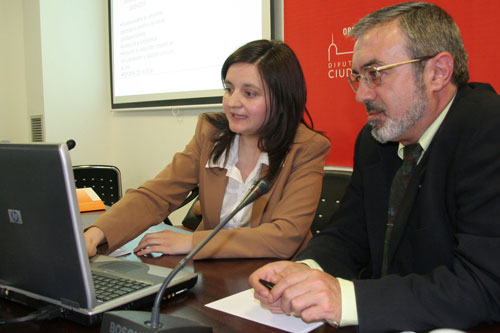Ciudad Real
May 6 - 8, 2025

09
may 2007
Miguel Pardo, Dean of the Faculty of Economics and Business Sciences of the University of Castilla-La Mancha and Ángela Triguero, Professor of the Spanish and International Economy Area of the same Faculty have analyzed "The Vineyard in Castilla-La Mancha and the Regional Economy".
Miguel Pardo, who is also Doctor in Applied Economy and expert in regional economy, has led the audience through a historical journey of Castilla-La Mancha's vineyard. "It must be made known that the regional economy's problems are not new ones, as they date back centuries", he underlined. He has also wanted to make it known that "the idea that the vineyard in Castilla-La Mancha has no future is a wrong idea, because if a company is competitive, then indeed it moves forward".
Pardo has analyzed the vineyard and the economic dynamics ranging from the 14th Century to the 18th Century, underlining that "it used to be an economy that was fundamentally based on migratory herding, subsistence agriculture and recuperation of the vineyard as a crop. Until 1750 agricultural economy was based on plowing and cereal expansion, but not on the vineyard, despite the rise in wine prices. The reasons for this were the livestock raisers' opposition and a lack of specialized labor, given that employment in agrarian manufacturing was more attractive", he explained. "Valdepeñas wines penetrated in Madrid and the regional per capita income was higher than the Spanish average", he added.
Between 1870 and 1900 the economy corresponded to a cereal agrarian model that was orientated towards the traditional model of single crops, cereal, vine and olive. Expansion of the vineyard was favored by France's phylloxera epidemic; by the arrival of phylloxera to Catalonia and the Valencia Region in 1890 and by the reduction of manufacturing jobs in the agrarian world. This was also the moment when a first step was taken leading to Castilla-La Mancha's capitalistic agriculture and the severity of the turn-of-the-century crisis in the rural world was reduced.
Expansion continued between 1900 and 1936, despite recuperation of the French production and the drop in wine prices. The vine turned into the region's main social crop; partial modernization of the wine industry took place, focused on the process but not on the product (low quality and scarce diversity) and growing presence on the national market and foreign dependence of the French market. Likewise a rather weak winegrower association movement seemed to take place.
The Law on Cooperatives was created in 1942, swiftly generating expansion of agrarian cooperativism. Mechanization and modernization of the regional agriculture was promoted, including viticulture.
It is as of 1986 that the vineyard surface starts to retreat, output improves, income is deteriorated and the vine-growers gradually get older, and an important investment is made in technological modernization of the facilities, quite frequently without any backing from organizational management and without any strategic planning to obtain returns.
"The current situation of the regional crop in this year 2007 is that we find ourselves with a competitive crop. There is no alternative for replacement in Castilla-La Mancha, no other crop has as many real and potential interlinking effects: backwards on the one hand; provisioning of inputs to the industry and forwards on the other: restaurant and tourist trade. The vineyard is an essential factor to boost sustainable development in Castilla-La Mancha in the 21st Century", he concluded.
WEAKNESSES AND THREATS OF THE REGIONAL ECONOMY'S CURRENT SITUATION
On her part, Ángela Triguero, expert in agricultural economy, has covered the fourth stage, analysis of the vineyard in Castilla-La Mancha, mentioning the weaknesses and threats that the current situation represents.
The Professor also analyzed the Common Market Organization of Wine; the effects of the same over the economy once it is approved and alternatives that cause "unfavorable" effects" for the vineyard. She also spoke about the problems of the viticulture and cooperative sector in the region.
Experts in regional and agricultural economy debated why cultivation of the vineyard is concomitant for the regional economy. Pardo put forward three reasons: because it is the most competitive and without alternatives in one of the least developed regions in the EU; because if added to the consequences of the climate change we reduce cultivation of the agricultural sector, this will represent effects over the region's social and economic sustainability. Finally, unlike other agricultural crops, this crop represents effects that offer opportunities related with rural tourism, gastronomic resources, etc.
We use our own and third-party cookies to manage the website, obtain information about its use, improve our services or to show you advertising according to your preferences. You can click on ACCEPT, to allow the use of all cookies, or on settings to see the cookies in detail and indicate which ones you want to accept or reject. +info
Settings